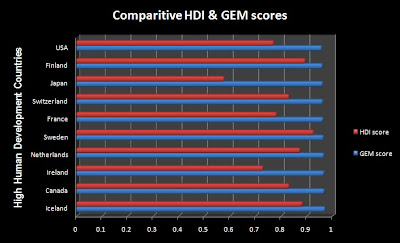 The Gender Empowerment Measure (GEM) pertains to the issue of gender-related development and the GDI. The GEM, however, is more specific; it compares the ability of men and women to participate in economic and political decision making. Simply put, the GEM measures the inequalities of men and women in a country. It, along with the GDI, is one of five indicators the UN uses in its annual Human Development Report.
The Gender Empowerment Measure (GEM) pertains to the issue of gender-related development and the GDI. The GEM, however, is more specific; it compares the ability of men and women to participate in economic and political decision making. Simply put, the GEM measures the inequalities of men and women in a country. It, along with the GDI, is one of five indicators the UN uses in its annual Human Development Report.
The GEM combines inequalities in three areas: political participation and decision making, economic participation and decision making, and power over economic resources. Calculating the GEM involves several steps. Percentages for females and males are calculated in each area of the following areas:
- The number of parliamentary seats held.
- a) The number of legislators, senior officials, and managers b) The number of professional and technical positions.
- Estimated earned income (at purchasing power parity US$).

 * It is interesting to note that no country has a GEM that is proportionate to its HDI. Because a country's GEM is not calculated into its HDI, it is not an effective means to evaluate direct comparisons. The graph does, however portray the gender inequalities in each of these MDCs. Equality should play a central component into how a country is "measured" and there seems to be universal discrepancies in this regard.
* It is interesting to note that no country has a GEM that is proportionate to its HDI. Because a country's GEM is not calculated into its HDI, it is not an effective means to evaluate direct comparisons. The graph does, however portray the gender inequalities in each of these MDCs. Equality should play a central component into how a country is "measured" and there seems to be universal discrepancies in this regard.
The various graphs below indicate different aspects that affect the GEM.
Although th
 is graph only represents a handful of countries, it is interesting that many developing countries have significantly higher gender equality in regards to parliamentary seats held by women than do some developed countries. However, when analyzing this aspect of the GEM as a whole, more MDCs do possess greater gender equality, with Western Europe ranking first in the world, while the Middle East ranks last.
is graph only represents a handful of countries, it is interesting that many developing countries have significantly higher gender equality in regards to parliamentary seats held by women than do some developed countries. However, when analyzing this aspect of the GEM as a whole, more MDCs do possess greater gender equality, with Western Europe ranking first in the world, while the Middle East ranks last.
 Again it is worthy to note that the proportion of women in political participation and decision making, and economic participation and decision making is not necessarily consistent with a country's level of development. Mongolia - a developing country has one of the highest percentage of female legislators, senior officials, and managers. Japan and Switzerland, on the other hand, hold top spots on global HDI rankings but have relatively low gender equality in this aspect.
Again it is worthy to note that the proportion of women in political participation and decision making, and economic participation and decision making is not necessarily consistent with a country's level of development. Mongolia - a developing country has one of the highest percentage of female legislators, senior officials, and managers. Japan and Switzerland, on the other hand, hold top spots on global HDI rankings but have relatively low gender equality in this aspect.

Again, the graph shows the inequality in men earned income over women. When strictly looking at this aspect of gender inequality, there seems to be no distinct difference between MDCs and LDCs. Qatar, a developed country has the one of the world's worst discrepancies, second only to Saudi Arabia. Japan, however, one of the world's leading industrialized nations possesses great inequality of women income - with females making less than half of what men do. The GEM poses some rather surprising information and clearly shows there is still much work to be done in the realm of gender equality.
References
“Gender Empowerment Measure”. (2009, November 29). Wikipedia. Retrieved December 12, 2009, from http://en.wikipedia.org/wiki/Gender_Empowerment_Measure
Human Development Report 2009. United Nations Development Programme. 2009. Retrieved from http://hdr.undp.org/en/media/HDR_2009_EN_Complete.pdf



